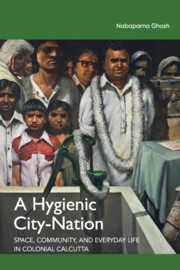Book contents
- Frontmatter
- Contents
- List of Figures, Tables, and Boxes
- List of Abbreviations
- Acknowledgements
- Introduction
- 1 The Black Town, Spaces of Pathology, and a Hindu Discourse of Citizenship
- 2 The Calcutta Improvement Trust: Racialized Hygiene, Expropriation, and Resistance by Religion
- 3 A City-Nation: Paras, Hygiene, and Swaraj
- 4 A New Black Town: Recolonizing Calcutta’s Bustees
- Epilogue
- Glossary
- Bibliography
- Index
2 - The Calcutta Improvement Trust: Racialized Hygiene, Expropriation, andResistance by Religion
Published online by Cambridge University Press: 26 June 2020
- Frontmatter
- Contents
- List of Figures, Tables, and Boxes
- List of Abbreviations
- Acknowledgements
- Introduction
- 1 The Black Town, Spaces of Pathology, and a Hindu Discourse of Citizenship
- 2 The Calcutta Improvement Trust: Racialized Hygiene, Expropriation, and Resistance by Religion
- 3 A City-Nation: Paras, Hygiene, and Swaraj
- 4 A New Black Town: Recolonizing Calcutta’s Bustees
- Epilogue
- Glossary
- Bibliography
- Index
Summary
In the last chapter, I discussed how the British tried to reduce all Indianneighbourhoods into an insanitary black town. In this chapter, I argue thatthe black town facilitated massive land acquisitions that powered alucrative market in land. The British began to plan Calcutta in the wake ofthe plague epidemic in 1898. The plague outbreak showed that earlier townimprovement committees had failed to improve the city's health.Improvement committees, such as the Lottery Committee and the Justices ofPeace, had planned new streets and filled up water bodies, but these werelocalized projects. The ravages of the plague mandated a complete reorderingof the entire city that assisted colonial land acquisitions. In 1911, thestate commissioned a town planning committee—the Calcutta ImprovementTrust—to draw a fresh plan for the city. The Trust's plansembraced Victorian notions of hygiene and advocated a new spatial order forCalcutta that required levelling and rebuilding Indian neighbourhoods.
In Victorian London, the state instructed citizens in hygiene. Healthofficers schooled city dwellers in scientific ways to dispose garbage, cleantheir houses, and maintain healthy bodies. But hygiene in nineteenth-centuryLondon meant more than clean spaces and bodies. It was tied to notions ofrespectability. The obsession of wealthy Londoners with hygiene contrastedwith the sweatand dirt-covered bodies of the workers, casting the former asrespectable and the latter as embodiments of shame. This divide alsoinformed city spaces, forcing the poor to live in separate neighbourhoodsaway from the rich. The state was aware of the wretched living conditions inthe poorer neighbourhoods but refused to extend civic amenities like modernstreets or sewers. Instead, health officers labelled the poor‘inherently unhygienic’, carriers of disease. This, in turn,strengthened class divides in the city.
The language of hygiene that nourished a class hierarchy in Britain, whenimported to India, fuelled a hierarchy of race. Colonial health officersviewed the Indians in the same way as they viewed the urban poor in London.To that end, they employed hygiene—defined entirely according toEnglish standards of sanitation—to condemn Indians as unhygienic bynature.
- Type
- Chapter
- Information
- A Hygienic City-NationSpace, Community, and Everyday Life in Colonial Calcutta, pp. 68 - 105Publisher: Cambridge University PressPrint publication year: 2020



